Have you ever asked yourself, “Hmm… What time should I feed my cat?” You’re not alone! Figuring out the perfect feeding schedule for your feline friend is a real puzzle for cat owners.
But it’s more than just a matter of convenience. A consistent feeding schedule is crucial for your cat’s health and happiness. Regular mealtimes can do wonders for their digestion, help them feel secure with a routine, and even prevent them from gobbling down too much food at once (which nobody wants!).
This article is your go-to guide for cat feeding times. We’ll explore everything from your cat’s innate instincts to their age and lifestyle, helping you figure out the best time to feed cats and create a feeding schedule that works purr-fectly for both of you.
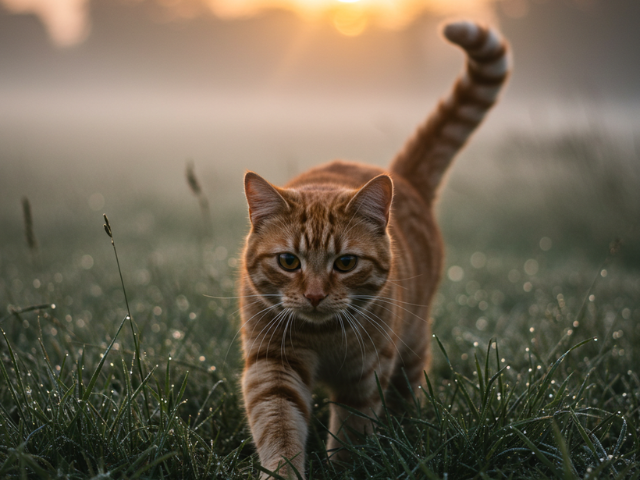
Your cat’s eating habits are rooted in nature. Cats are crepuscular hunters, meaning they’re most active during dawn and dusk. Serving food at these times can align with a cat’s natural hunting instincts, potentially making the feeding experience more engaging and instinctual for them.
A steady feeding schedule also supports digestive health. Regular meal times help your cat’s tummy get into a rhythm, reducing the risk of digestive upsets that come with erratic eating patterns.
Beyond the physical benefits, a predictable schedule gives your cat a sense of security. It’s like having a mini celebration at feeding time, a moment to bond with you through gentle petting and praise. Remember, feeding isn’t just about nutrition but also connecting with your pet and making them feel safe.
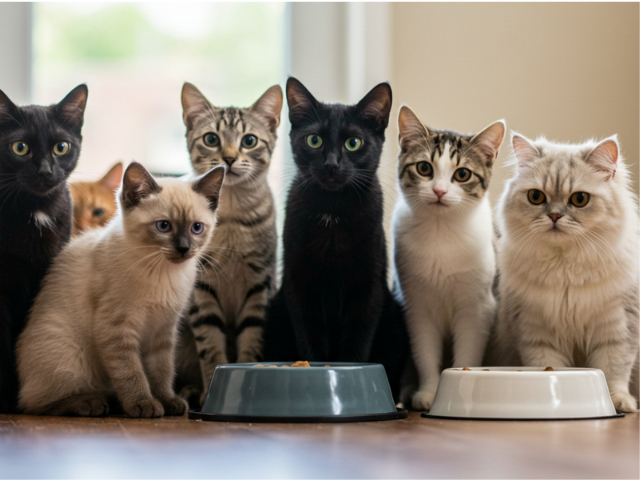
Determining the best times to feed your cat isn’t one-size-fits-all. Several factors influence the optimal cat feeding times.
Kittens have tiny tummies and high energy needs. They require frequent, small meals to fuel their growth. Once they are six months old, kittens should eat three to four times daily. Specific kitten feeding times might be:
Most adult cats thrive on eating their meals twice a day. Establishing consistent cat feeding times, such as once in the morning and once in the evening, helps maintain their health.
Senior cats may need adjusted feeding schedules. Due to changes in metabolism or dental issues, they might prefer smaller, more frequent meals. Observing your senior cat’s behavior helps determine the best times to feed your cat at this stage.
Active cats burn more calories. Since they are playful and energetic, they might need more frequent meals or larger portions. Conversely, less active cats may require smaller meals to prevent weight gain. Whether your cat is indoors or outdoors impacts their energy needs and cat feeding times.
Certain health issues require specific feeding schedules. For example, diabetic cats need meals timed with insulin injections. Cats with kidney disease or hyperthyroidism have special dietary needs. Always consult your veterinarian to decide what time you should feed your cat if they have medical conditions.
Timed meals involve offering food at specific times, while free-feeding allows your cat to graze all day. Timed meals prevent overeating and help monitor intake, influencing what time to feed your cat. Controlled free-feeding might suit some cats but requires careful portion control.
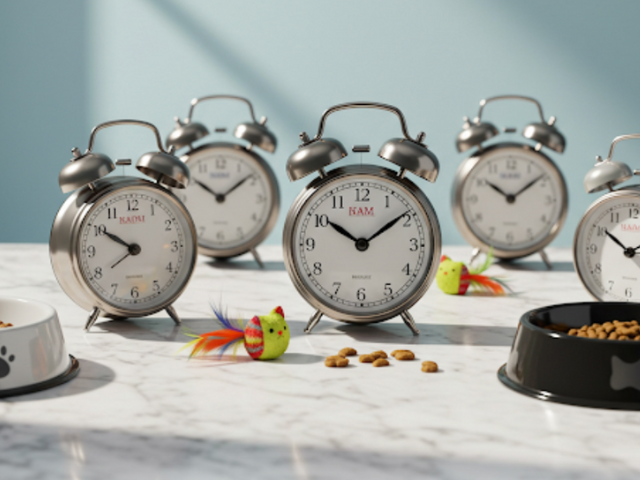
Now that you know what to consider, let’s discuss how to make a feeding schedule that works for you and your cat.
Since cats are most active at dawn and dusk, these are good times to feed them. You might feed your cat around 7 AM and then again around 6 PM. These times follow their natural hunting patterns and can help keep them satisfied.
Maintain a consistent schedule every day, including weekends, to prevent confusing your cat. Consistency provides security for your cat and minimizes the likelihood of them begging for food between meals.
Most adult cats should eat two meals a day. However, if a cat is less active, one meal a day might be enough, but only if you carefully control the portion size. Always watch your cat’s weight and behavior to ensure they get the right portion of food.
Here are a few examples of daily cat feeding time schedules:
Feel free to adjust these times to fit your schedule. The key is to be consistent.
Life happens, and sometimes you might need to adjust your cat’s feeding schedule slightly. A little flexibility in feeding time is okay, but avoid making significant changes. Drastic changes can stress your cat. If you know you will be late, try using an automatic feeder to keep your cat on schedule.
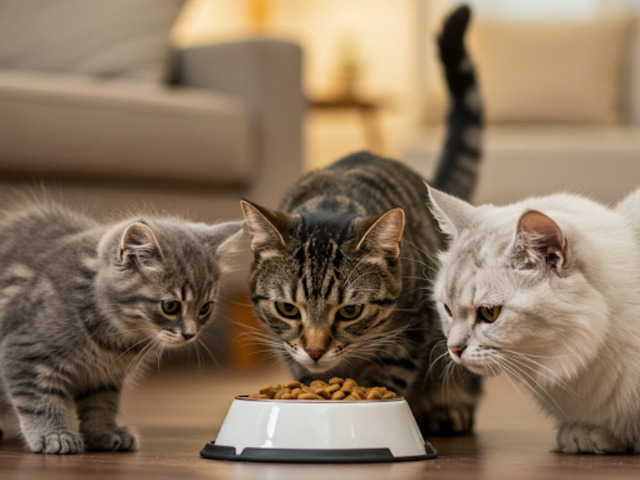
Let’s look at specific situations where you may need to adjust when you feed your cat: kittens, elderly cats, and cats with medical issues.
Kittens are growing machines! They need frequent fueling to support all that bouncing, pouncing, and growing. Here’s a general breakdown of feeding frequency for kittens of different ages:
The key for kittens is small and frequent. Their tiny tummies can’t handle large volumes of food at once. Spread their meals throughout the day to provide consistent energy for their boundless kitten energy! Always use high-quality kitten food formulated for their specific nutritional needs.
Senior cats can present a bit more of a puzzle. Some maintain excellent appetites, while others become more finicky or experience digestive changes.
Monitor your senior cat closely for any change in appetite, weight loss, or digestive issues like vomiting or diarrhea. These could be signs of underlying health concerns or age-related changes affecting their digestion.
You might need to adjust the quantity of food based on their weight and activity level. If they become less active, they might need slightly smaller portions to avoid weight gain. If your pet is losing weight and it’s not due to a health problem, you may need to give them more food.
You might also consider slightly more frequent, smaller meals if they have trouble eating large portions at once.
Many senior cats, especially those with dental issues, prefer softer, wet food. It’s easier for them to chew and digest. If you notice your senior cat struggling with dry kibble, talk to your vet about transitioning to a wet food diet or moistening their dry food.
A senior cat maintaining good weight and appetite might continue with a twice-a-day schedule, perhaps around 8 AM and 6 PM. If you notice digestive sensitivities or smaller appetites, try offering smaller meals three times a day, like 7 AM, 1 PM, and 7 PM.
As mentioned earlier, veterinarian-prescribed diets and feeding schedules are crucial for cats with health conditions—it’s not something to guess!
Your vet will recommend specific types of food and feeding schedules based on your cat’s condition. Cats with kidney disease often need special low-phosphorus diets, and diabetic cats need timed meals around insulin administration.
For diabetic cats, cat feeding times are often directly linked to insulin injections. Typically, a vet will recommend feeding your cat right before or right after their insulin shot. It helps synchronize food intake with insulin action to regulate blood sugar. Your vet will give you the precise timing based on the type of insulin and your cat’s needs.
Cats with kidney disease might benefit from special kidney diets and potentially smaller, more frequent meals. Smaller meals can be easier on their digestive system and help with nutrient absorption. However, the specific frequency and diet are best guided by your veterinarian.
Your vet is your best resource for determining the best times to feed your cat and the appropriate diet. Don’t hesitate to ask them for detailed feeding instructions.
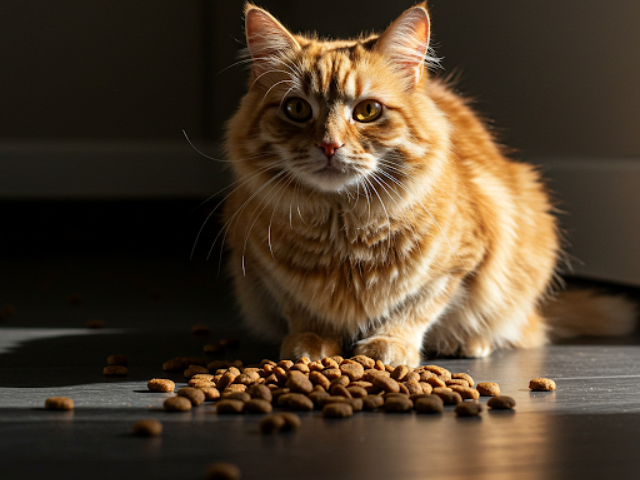
There are plenty of myths out there about cat feeding. Here are some of them:
While some cats might seem okay with one large daily meal, it’s generally not ideal. Large, infrequent meals can lead to overeating and even digestive issues.
Free-feeding might work for some cats. However, it can lead to obesity and make it hard to monitor food intake.
In truth, a set schedule is better for portion control and maintaining your cat’s energy levels.
Your feline’s nutritional needs are specific, and some human foods can be dangerous.
Yes, you can slowly adjust the schedule. Consistency is more important than the exact time.
Consider using an automatic feeder or splitting meals to cover busy periods.
Watch your cat’s behavior, energy levels, and weight. A healthy cat will show steady activity and consistent energy.
These clarifications will help you avoid common pitfalls and set up a feeding plan that works for you and your cat.
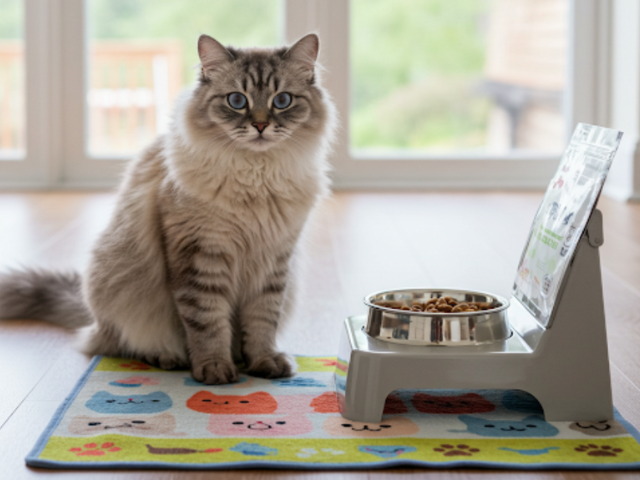
Creating and maintaining a feeding routine ensures your cat’s health and happiness.
Watch for signs of problems related to cat feeding.
Consult your veterinarian if you notice any issues.
Always provide access to fresh, clean water. Hydration is vital, regardless of your cat’s feeding proportions and schedule.
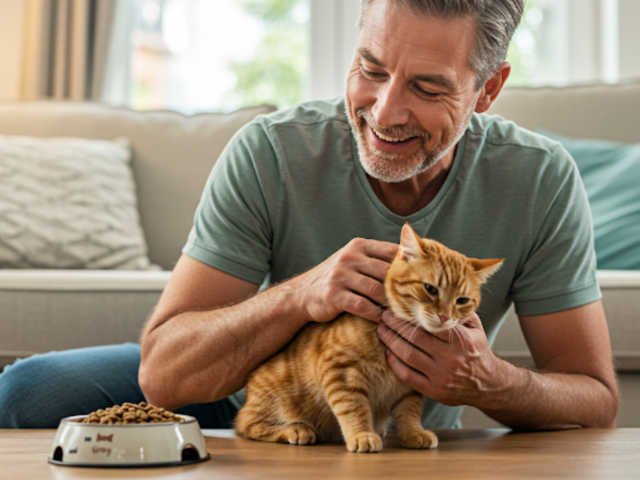
There’s no single answer to the question, “What time should I feed my cat?” The most important thing is to be consistent, pay attention to your cat’s needs, and create a schedule that works for both of you. A well-planned feeding routine will lead to better digestion, less stress, and a happier, healthier feline friend.
Want to make your cat’s feeding routine even better? Visit our cat supplies store, ZezeLife, for high-quality feeding bowls, drinking fountains, and other helpful accessories to support a healthy cat feeding time routine. We’re here to help you give your cat the best possible care and enhance the joys of cat ownership with responsible pet care.

